With the test matches of India vs Pakistan standing canceled or postponed until further notice due to the coronavirus outbreak, we draw upon few comparisons between these two nations, to ensure citizens from these developing economies keep their sportive spirit high during these trying times.
While the respective governments of India and Pakistan are pulling out all stops to wage a war against the raging coronavirus pandemic, we look at the statistical findings (the numbers and data) provided by the Ministry of Health from both regions, to know where we stand - not only as different nations in the coronavirus combat, but overall in the fight for humanity.
Status of India in Coronavirus war
According to state-wise data released by the Ministry of Health and Family Welfare (MoHFW), Maharashtra, Tamil Nadu and Delhi continued to remain the hotspots accounting for more than 40% of the total coronavirus case in India. The total number of coronavirus cases in the country as of April 8 stands at 5,274, according to the Ministry of Health. The deaths caused by coronavirus is 149 and 410 are totally cured or discharged from the hospitals.
Maharashtra has the highest number of coronavirus cases among all states of India - 1,018 confirmed coronavirus positive, 79 cured or discharged and 64 deaths in the state. In Tamil Nadu, the total number of coronavirus cases has increased to 690 with 7 deaths recorded so far. While in Delhi, the active cases count has risen to 576, with 9 succumbing to death caused by the disease thus far. There has also been a noted increase in active coronavirus cases in the states of Kerala, Uttar Pradesh, and Telangana at 336, 343, and 427 respectively.
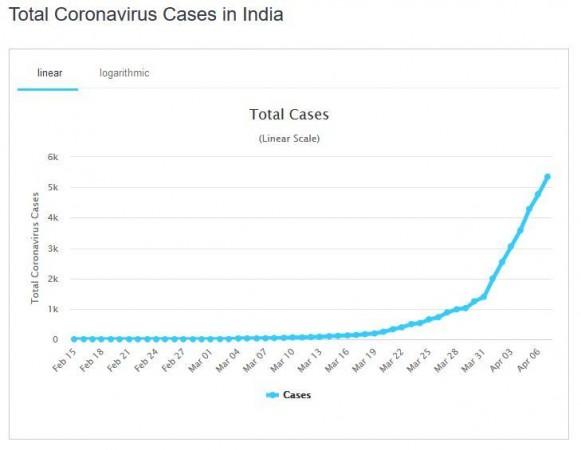
Rajasthan has registered 328, Andhra Pradesh at 305, and Madhya Pradesh with 229 confirmed active coronavirus cases. In the state of Gujarat, 165 active cases were identified and 13 deaths were reported. The tally in the state of Karnataka has surged to 175 with 4 fatalities. Punjab reports 91 cases, in Haryana 147, Bihar -38, Chandigarh - 18, and 14 coronavirus cases in Ladakh have been detected so far.
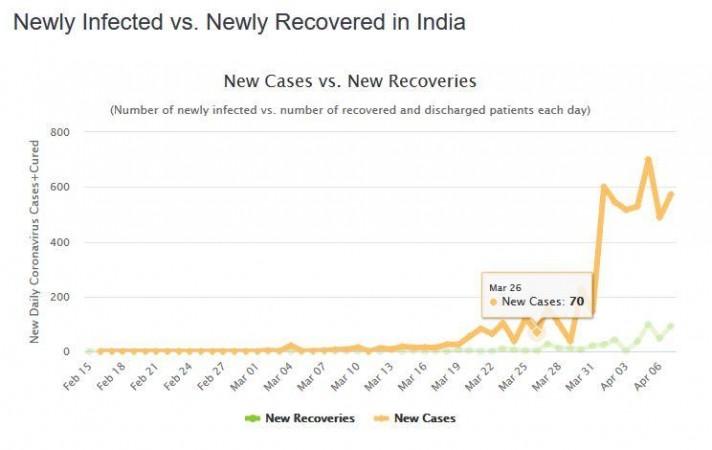
Where does Pakistan stand in the coronavirus combat?
In Pakistan, as of data on April 8, the nation has reported 4,183 confirmed coronavirus positive cases, 60 deaths in total and 467 patients have been recovered so far. The highest number of cases are in Pakistan-owned Punjab at 2,108, followed by Sindh recording 1,036, two new confirmed coronavirus cases in Balochistan today has increased the tally count to 212, Khyber Pakhtunkhwa (KP) has 527, Islamabad recorded 83, Gilgit-Baltistan (GB) at 211, and Pakistan-occupied Kashmir 28 cases have been identified so far.
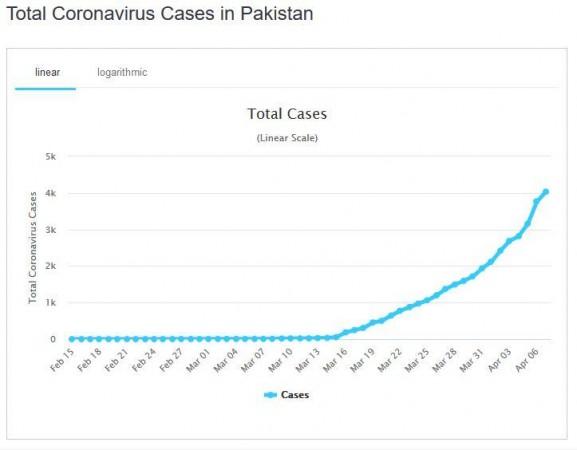
The authorities have conducted 42,159 tests, of which 3,076 tests have been conducted in the last 24 hours. Accurate province and region-wise data of confirmed coronavirus cases was not available on the ministry's website as it was being updated.
Prime Minister Imran Khan has warned people to follow government guidelines on self-isolation, social distancing to curb the spread of the virus via human-to-human transmission.
The Pakistan government expects a surge in coronavirus cases by the end of April, and it says healthcare is not equipped to deal with this rapidly transmitting virus. The government intends to start distributing Rs 144bn among 12mn families from tomorrow as an 'extremely transparent' relief program to protect families during the crisis.
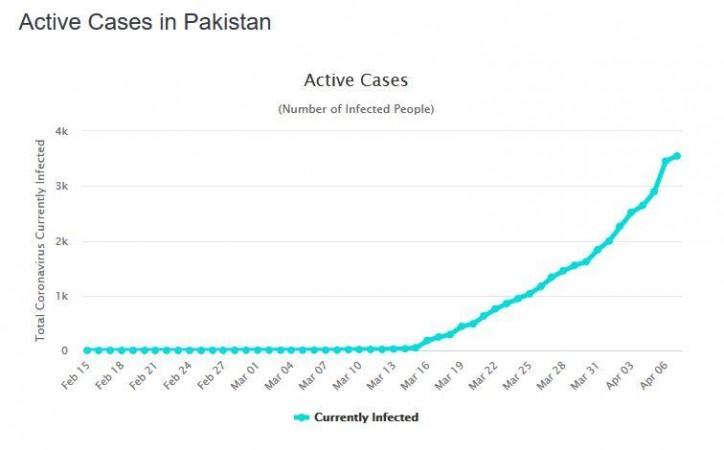
Looking beyond numbers: India's competitive edge over Pakistan
Looking beyond the coronavirus case count in both nations, there are several other parameters to be considered. The battle against coronavirus is still on. India is well-equipped with coronavirus testing facilities - 136 government laboratories and 56 private laboratories have been made functional. These laboratories have a capacity of conducting 18,000 tests per day. The Supreme Court of India has issued an order that COVID-19 testing will be conducted free of cost at both approved government and private labs.
ICMR last week issued an advisory to start rapid antibody-based blood testing in areas reporting clusters and in large migration gatherings or evacuee centers to identify COVID-19 suspects immediately. Also, the real-time RT-PCR tests are increasing, so there is simply no way any country can win without extensive testing labs and processes in place to tide over the situation.

Several other measures are also implemented by the Centre such as 21-day national lockdown, government benefits and schemes for the poor such as the provision of food and essentials for the daily wage workers and economically weaker sections of society, an extension of MGNREGA (Mahatma Gandhi National Rural Employment Guarantee Act) for harvesting activities and deferment in EMIs for the next 3 months, etc.
Pakistan has a relatively lesser population in comparison to India. It lacks a sufficient number of PPEs to protect healthcare professionals and people in the region, but what the nation has today is not what other countries could possibly imagine. PM Imran Khan in his recent announcement has put the Corona Relief Tiger Force on the job. While India has deployed personnel from national healthcare and security forces, from defence, police, and army to manage the lockdown, control people movement across states and help those in need, it seems Pakistan's National Security Committee, the coordination centre and commandos operation wing aren't up to the task. Hence, the PM Imran Khan had to call upon the Corona Relief Tiger Force instituted by the government to deal with the pandemic.
The Corona Relief Tiger Force comprises more than 8,00,000 'registered members' who are volunteers (normal individuals) comprising students, teachers, lawyers, social workers, journalists, doctors, and even retired armed forces personnel, who have been deployed to take control of the situation. Now, these are not all healthcare professionals, neither defence personnel but regular individuals from different walks of life given the humongous job of combating Corona.
According to Imran Khan's 2F strategy to fight the pandemic: Fund for corona and Force of tigers. The Corona Tiger Force is mandated to first find out the needy or the unemployed, then go door-to-door to provide ration to economically weaker sections of society and spread awareness about the coronavirus safety measures. Is this what the healthcare professionals and the people of Pakistan really want from the Government?
In other words, the Pakistan government displays a lackadaisical attitude in fighting against coronavirus by simply entrusting the responsibility of care and control in the hands of its fellow citizens alone, thus washing hands off the situation, with partial involvement and not a fiercely bullish approach.
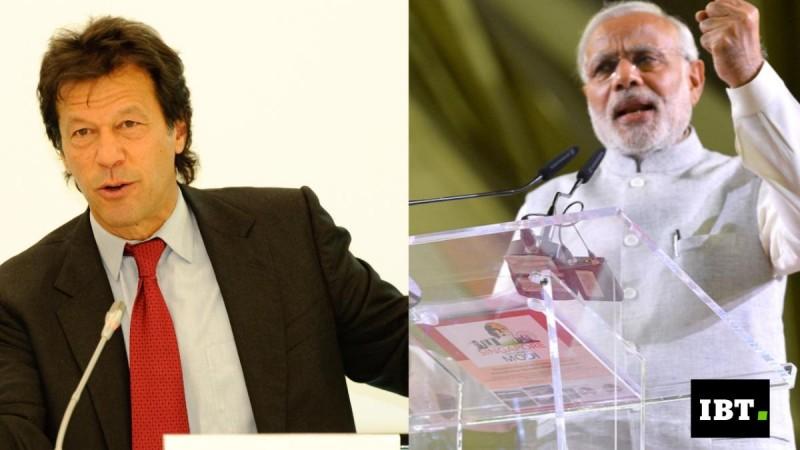
India, on the other hand, is leaving no stone unturned to fight out the virus from the nation. Besides imposing nationwide lockdown, providing food for the daily-wage workers, reaching out globally to countries in the UN for help, seeking state intervention by holding a meeting with ministers and implementing immediate remedial measures recommended by ICMR, adhering to orders issued by MoHFW, increasing COVID-19 testing centers, labs and facilities in the country; sealing down state borders and clusters in different states wherein a large number of confirmed positive cases were identified - all these and more containment measures are put into place. But are still behind the global curve in fighting coronavirus better.
In a nutshell: The fight against coronavirus continues
These times of uncertainty have put the governments of both India and Pakistan in an observation mode, with clinical trials underway in many countries to find a complete cure for the novel coronavirus. Experimentation using hydroxychloroquine and pairing it with other drugs as a potential treatment for COVID-19 patients is an experimentative step, and doctors are researching if repurposing hydroxychloroquine will do more harm than good on Coronavirus infected.
What will happen after the nationwide lockdown gets uplifted on April 14? The Prime Minister of India, Narendra Modi and the cabinet ministers held a meeting yesterday mulling an extension of the lockdown if possible, and strategies to open up industries and services slowly post the lockdown are being devised. Does Pakistan have a plan to deal with the crisis and thinking about the long-term consequences? Only time will tell.

















